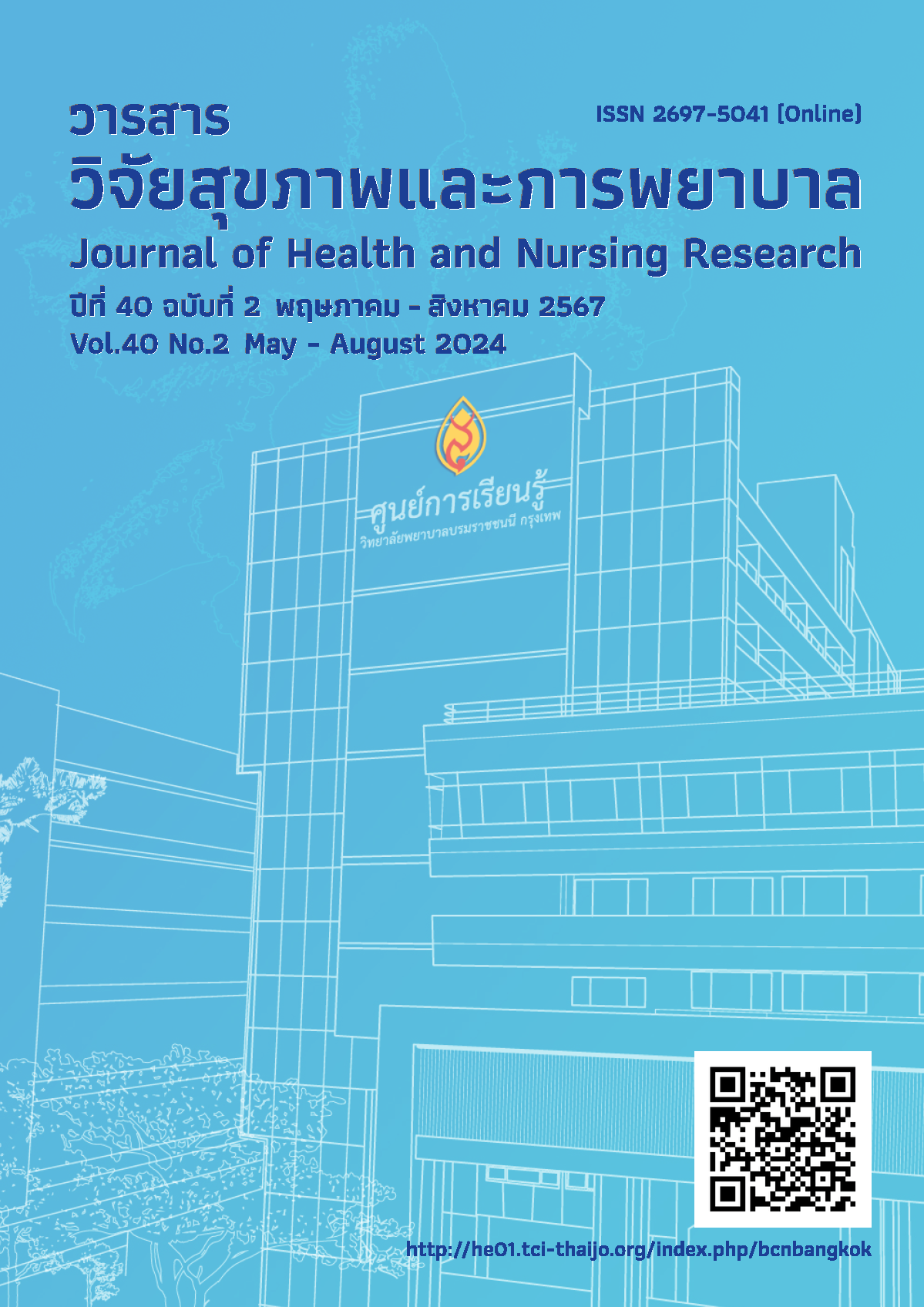ประสิทธิผลของการใช้แนวปฏิบัติการพยาบาลสำหรับผู้ป่วยติดเชื้อในกระแสเลือด แผนกอุบัติเหตุฉุกเฉิน โรงพยาบาลไกรลาศ จังหวัดสุโขทัย
คำสำคัญ:
แนวปฏิบัติการพยาบาล, ผู้ป่วยติดเชื้อในกระแสเลือด, แผนกอุบัติเหตุฉุกเฉินบทคัดย่อ
บทนำ: การใช้แนวปฏิบัติการพยาบาลสำหรับผู้ติดเชื้อในกระแสเลือดที่มีมาตรฐาน จะเป็นแนวปฏิบัติในการดูแลผู้ป่วยให้ปลอดภัยและมีประสิทธิภาพยิ่งขึ้น
วัตถุประสงค์การวิจัย: เพื่อพัฒนาและศึกษาผลของการใช้แนวปฏิบัติการพยาบาลสำหรับผู้ป่วยติดเชื้อในกระแสเลือดแผนกอุบัติเหตุฉุกเฉิน โรงพยาบาลกงไกรลาศ จังหวัดสุโขทัย
ระเบียบวิธีวิจัย: การวิจัยเชิงปฏิบัติการประกอบด้วย 4 ขั้นตอน ได้แก่ 1) การวางแผน พัฒนาแนวปฏิบัติ วิเคราะห์ทบทวนแนวทางการดูแลผู้ป่วย ค้นหาปัญหาและอุปสรรค และนำข้อมูลที่ได้มาวิเคราะห์ 2) การปฏิบัติการพัฒนาแนวปฏิบัติ และนำไปใช้กับผู้ป่วยตามแผน 3) การติดตามผลการปฏิบัติ สังเกตและติดตามผลลัพธ์ และ 4) การสะท้อนคิด คัดเลือกกลุ่มตัวอย่างแบบเฉพาะเจาะจง จากผู้ป่วยที่ได้รับการวินิจฉัยมีภาวะติดเชื้อในกระแสโลหิตที่เข้ารับการรักษาที่แผนกอุบัติเหตุฉุกเฉิน โรงพยาบาลกงไกรลาศ แบ่งเป็น 2 กลุ่ม ได้แก่ กลุ่มเปรียบเทียบและกลุ่มทดลอง กลุ่มละ 30 คน และพยาบาลวิชาชีพที่ปฏิบัติงานในแผนกอุบัติเหตุฉุกเฉิน จำนวน 11 คน เครื่องมือที่ใช้ในการวิจัย ได้แก่ แนวปฏิบัติการพยาบาลสำหรับผู้ป่วยติดเชื้อในกระแสเลือด ฯ แบบบันทึกการดูแลรักษาผู้ป่วย และแบบประเมินความพึงพอใจของพยาบาลวิชาชีพต่อการใช้แนวปฏิบัติการพยาบาล ฯ วิเคราะห์ข้อมูลโดยค่าความถี่ ร้อยละ ค่าเฉลี่ย ค่าเบี่ยงเบนมาตรฐาน และเปอร์เซ็นต์ความแตกต่าง
ผลการวิจัย: แนวปฏิบัติสำหรับผู้ป่วยติดเชื้อในกระแสเลือดห้องอุบัติเหตุและฉุกเฉิน ประกอบด้วย 1) การคัดกรองผู้ป่วย (Triage) 2) การพยาบาลภาวะฉุกเฉิน 3) การประสานเพื่อเข้ารับการรักษาในโรงพยาบาล และผลจากการใช้แนวปฏิบัติ ฯ อัตราการตายลดลง ร้อยละ 60 ภาวะแทรกซ้อนจากการติดเชื้อในกระแสเลือดลดลง ร้อยละ 71.48
อัตราการส่งต่อภายหลัง Admit 1 ชั่วโมงแรกลดลง ร้อยละ 21.43 และพยาบาลวิชาชีพมีความพึงพอใจต่อแนวปฏิบัติอยู่ในระดับมาก (M = 4.64, SD = .49)
สรุปผล:แนวปฏิบัติการพยาบาลสำหรับผู้ป่วยภาวะติดเชื้อในกระแสเลือดในแผนกฉุกเฉินมีประสิทธิภาพในการเพิ่มผลลัพธ์การศึกษา และเพิ่มความพึงพอใจของพยาบาลวิชาชีพ
ข้อเสนอแนะ:แนวปฏิบัติมีประสิทธิภาพ เป็นแนวทางประยุกต์ใช้ในแผนกอุบัติเหตุฉุกเฉิน โรงพยาบาลอื่นต่อไป
Downloads
เอกสารอ้างอิง
Worldsepsisday. Sepsis-guidance [Internet]. 2024 [cited 2024 Feb 7]. Available from: https://golink.icu/QHnGg8i
Ministry of Public Health. Mortality rate in patients with severe community-acquired bloodstream infection [Internet]. 2019 [cited 2024 Feb 7]. Available from: https://golink.icu/dFY23uV (in Thai)
Saengsanga P, Kiamkan N. Outcomes of using the clinical practice guidelines for patients with severe sepsis or septic shock care according to sepsis bundle protocol at the ICU of Songkhla hospital Thailand. Region 11 Medical Journal 2015;29(3):403-10. (in Thai)
Vans L, Rhodes A, Alhazzani W, Antonelli M, Coopersmith CM, French C, et al; Executive summary: Surviving sepsis campaign: International guidelines for the management of sepsis and septic shock 2021. Critical Care Medicine. 2021;49(11):1974-82. doi: 10.1007/s00134-021-06506-y.
Chairatana P, Tudsapornpitakkul S. The effectiveness of nursing care model for sepsis patients. Journal of Nursing and Health Care 2017;35(3):224-31. (in Thai)
Department of Medicine: Department of Medical Affairs. Guideline for emergency room services that are appropriate to the capacity level of healthcare facilities. 2018 [cited 2024 Jan 6]. Available from: https://www.dms.go.th/Content/Select_Content_11_ViewContent?contentCategoryId=11&contentTypeId=0&contentId=10. (in Thai)
Levy MM., Evans LE., Rhodes A. The surviving sepsis campaign bundle: 2018 update. Critical Care Medicine. 2018;46(6).997-1000. Available form: https://url.in.th/brAzW
Chua WL, Teh CS, Basri MABA, Ong ST, Phang NQQ, Goh EL. Nurses' knowledge and confidence in recognizing and managing patients with sepsis: A multi-site cross-sectional study. Journal Advance of Nursing 2023;79(2):616-29. doi: 10.1111/jan.15435
Alsadaan N, Salameh B, Reshia FAAE, et al. Impact of nurse leaders behaviors on nursing staff performance: A systematic review of literature. Inquiry. 2023;60:469580231178528. doi: 10.1177/00469580231178528
Rungthanakiat P, Promtuang S, Paengbuddee C. Development of the care model for patients with septicemia using fast tract system at Surin hospital. Journal of Nursing and Midwifery Practice 2019;6(1): 36-51. Available from: https://he02.tci-thaijo.org/index.php/apnj/article/view/192024/144292 (in Thai)
Mitzkewich, M. Mitzkewich M. Sepsis screening in triage to decrease door-to-antibiotic time. Journal of Emergency Nursing 2019;45(3):254-6. doi: 10.1016/j.jen.2018.08.002.
Waranung T. Outcomes of using the clinical practice guideline for patients with sepsis Fang hospital, Chiangmai province. Chiangrai Medical Journal 2019;11(1):1-8. Available from: https://he01.tci-thaijo.org/index.php/crmjournal/article/view/179719/135424 (in Thai)
Karaket A, Talerd W. Development of clinical nursing practice guideline among adult and elderly patients with severe sepsis in emergency department at Rasisalai hospital, Sisaket province. Journal Health Science Thai. 2018;27(4):688-9.Available from: https://thaidj.org/index.php/JHS/article/view/4309/3953 (in Thai)
Kemmis S, McTaggart R. The action research planer. 3rd ed. Victoria: Deakin University; 1988.
Polit DF, Hungler BP. Nursing research-principle and methods. Lippincott Williams & Wilkins, Philadelphia;2004.
Best JW. Research in education. 3rd ed. Englewood Cliffs: N.J. Prentice-Hall; 1977.
Phonyiam N, Singkleeprapha P, Sansuk M. Using the six bundle sepsis protocol for caring patientswith severe sepsis or septic shock, emergency department, Kumphawapi hospital. Udonthani hospital. Medical Journal 2018;26(2):189-200.Available from: https://he02.tci-thaijo.org/index.php/udhhosmj/article/view/159195/115156 (in Thai)
Intachub S, Posri D, Suwannasr J. Outcomes of using the MEWS (SOS Score) that affected the severe sepsis and septic shock in sepsis patients at medical department, Udonthani hospital. Udonthani Hospital Medical Journal 2017;25(1):85-92. Available from: https://he02.tci-thaijo.org/index.php/udhhosmj/article/view/159158/115140 (in Thai)
Limrungyeunyong M. Development of fast-track nursing guidelines for sepsis patients at emergency room [Internet]. 2021 [cited 2024 January 25]. Available from: http://hpc2appcenter.anamai.moph.go.th (in Thai)
Gavelli F, Castello LM, Avanzi GC. Management of sepsis and septic shock in the emergency department. Internal and Emergency Medicine. 2021;16(6):1649-1661. doi: 10.1007/s11739-021-02735-7
ดาวน์โหลด
เผยแพร่แล้ว
รูปแบบการอ้างอิง
ฉบับ
ประเภทบทความ
สัญญาอนุญาต
ลิขสิทธิ์ (c) 2024 วารสารวิจัยสุขภาพและการพยาบาล (วารสารวิทยาลัยพยาบาลบรมราชชนนี กรุงเทพ)

อนุญาตภายใต้เงื่อนไข Creative Commons Attribution-NonCommercial 4.0 International License.
บทความที่ได้รับการตีพิมพ์ เป็นลิขสิทธิ์ของวารสารวิจัยสุขภาพและการพยาบาล (วิทยาลัยพยาบาลบรมราชชนนี กรุงเทพ) ไม่สามารถนำไปตีพิมพ์ซ้ำในวารสารฉบับอื่น


















